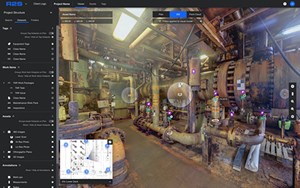Digital transformation: Digital twins help to make the invisible, visible in Indonesia’s energy industry
Nestled amid the equatorial seas, Indonesia emerges as a mesmerizing archipelagic state. A sprawling tapestry of over 17,000 islands, and spanning one-eighth of the Earth’s circumference, this vast expanse is a testament to nature's abundance.
Amid this beauty lies an energy-rich heart, where geothermal power is drawn from the Earth's core, and ocean tides beckon as an untapped source of renewable potential. But it also has a rich oil and gas heritage, with the industry’s production peaking in the 1990s.1
CHALLENGES IN INDONESIA’S ENERGY INDUSTRY
However, over the last few decades, the country has faced challenges, such as declining reserves, aging oil and gas infrastructure, and regulatory issues, leading to a decrease in oil production and a shift towards natural gas, as a lower-emissions alternative.
Oil and gas will continue to play a major role in Indonesia’s varied energy portfolio, ensuring domestic energy security, but to continue to do so, certain challenges will need to be addressed. The decline in production is owed to the country’s particular set of challenges, such as investment frameworks, field development solutions and the balance between national and private entity interests. Introducing digital solutions that deliver increased efficiencies can, therefore, prove to be challenging.
CONNECTING THE DOTS AND DIGITALIZING THE ARCHIPELAGO
Key to solving this is awareness that digitalization could provide a solution to a sector with many data silos. Digitalizing operations can bring a whole host of benefits, such as reducing asset downtime and improving worker productivity and on-site execution efficiency. This is done by bringing together data that help to paint a vivid picture of an asset’s real-time status.
In Indonesia, assets are typically in very remote locations, with limited data connectivity. Modern digital systems can support the rapid integration of data to allow engineers and managers to instantly visualize the reality of the situation without wasting time on lengthy data gathering activities. Centralized digital systems can bring together asset data from the most remote corners of Indonesia, helping local oil and gas companies, as well as government entities, which provide support and funding, to better understand the safety and operating status of energy hubs and assets within its operation.
Digitalized data is vital when dispersed teams are operating on the ground in different locations. From mobile phones to social media, digital technology connects us, helping to bring the disparate islands of the archipelago together.
Digital solutions providers on the ground, across the islands, can help Indonesian energy producers access enriched views of their assets through centralized, digitalized systems of data management. Pin-pointing exact anomalies, faults and risks, this real-time overview of an aging infrastructure, in remote and unforgiving environments, can plug the gaps in operations.
With even newer technologies like digital twins, Indonesian operators can access reality data, helping them to monitor assets and operations across the archipelago. Through this, pre-planning of maintenance, as well as the delivery and quality assurance of major projects, plays a large role in the broader regional energy context.
Additionally, some digital twin software models can connect site imagery to existing data, to give operators a detailed view of their assets. For Indonesia’s aging infrastructure, this could provide significant opportunities to maximize output as the assets degrade.
CONNECTING THE DOTS AND BUILDING RELATIONSHIPS TO FOSTER GROWTH
While digitalization might plug the gaps and connect the dots, just as it connects dispersed asset data, companies can be wary of taking a risk of investing in the search for a return on investment. However, the opportunity to deliver more value from assets remains. By partnering with software companies—those with local, geographical and historic knowledge of sites, to support exploration, drilling and production—national oil companies (NOCs) and smaller, local energy production companies in Indonesia can find their operations vastly maximized.
Hesitancy to change can be common, particularly when the stakes of energy security—a key concern of NOCs—are high. For this reason, digital solutions providers looking to make headway in the region need to consider adapting their approaches, building bridges with flexibility in mind.
Met with wariness in some instances, these companies will be wise to take local nuances into consideration. Historically, long-lasting partnerships across the industry have been fostered through consultative-style processes. Through this, confidence is built, trust is instilled, and progress is made.
By being adaptable, Indonesia’s oil and gas companies can have renewed confidence in adopting innovative technologies—such as digital twins, data analytics, and predictive maintenance—by making smaller changes in the first instance, and then building on top of that success.
This model could mean that Indonesian energy companies are keener to adopt advanced technologies like data analytics and predictive maintenance, ultimately bolstering their operations. With this growth, seeing a return on investment should instill further confidence in these partnerships and technologies, giving Indonesian firms the option to scale operations and adoption.
And the proof has been in the pudding, with companies that have already adopted this digital approach. With digital twins providing access to reality data, Indonesian operators have eyes on assets and operations 3,000 kms away, making the invisible, visible. This has already been done at a remote LNG production facility in Indonesia, where James Fisher AIS’ R2S digital twin meant that the team could cut down on the 20 hrs of flight time and boat journey to reach the facility from the nearest hub city, as well as increase collaboration across the dispersed team, Fig. 1.
LOOKING TO THE FUTURE
Indonesia has previously prioritized energy security over becoming a major energy exporter. However, this could be set to change, as the nation begins to take its place within the global energy transition. This includes agreements in place to export clean energy to Singapore, and recent progress made in prioritizing natural gas and geothermal energy.
Indonesia has clear ambitions to grow its energy industry across sectors and bolster its power generation, too. With this, it ensures that in the future, lower-carbon-intensity energy sources also have a part to play in both the energy transition and energy security of the region.
Across oil and gas, geothermal and natural gas, it’s clear that digital solutions and flexible business models that put energy companies and their pain points first, will be key to achieving these.
REFERENCE
- https://theenergyyear.com/market/indonesias-energy-industry/

- The future of connectivity and automation in wellsite operations and workflows (January 2025)
- Digital transformation: Next-generation flexible control system modernizes wellsite operations (January 2025)
- Digitalizing training management and delivery (December 2024)
- Sustainability: Meeting new drilling demands with smarter power management (November 2024)
- Digital control architecture optimizes plunger lift wells (November 2024)
- Automated iron roughneck and advanced robotics system enhance rig floor operations (September 2024)



